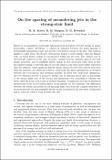Files in this item
On the spacing of meandering jets in the strong-stair limit
Item metadata
| dc.contributor.author | Scott, R. K. | |
| dc.contributor.author | Burgess, B. H. | |
| dc.contributor.author | Dritschel, D. G. | |
| dc.date.accessioned | 2022-05-12T14:30:23Z | |
| dc.date.available | 2022-05-12T14:30:23Z | |
| dc.date.issued | 2022-01-10 | |
| dc.identifier | 277786864 | |
| dc.identifier | 846cc80e-c077-442a-b4f4-b9fce41676f6 | |
| dc.identifier | 85120035344 | |
| dc.identifier | 000717040000001 | |
| dc.identifier.citation | Scott , R K , Burgess , B H & Dritschel , D G 2022 , ' On the spacing of meandering jets in the strong-stair limit ' , Journal of Fluid Mechanics , vol. 930 , A20 . https://doi.org/10.1017/jfm.2021.898 | en |
| dc.identifier.issn | 0022-1120 | |
| dc.identifier.other | ORCID: /0000-0001-5624-5128/work/108118659 | |
| dc.identifier.other | ORCID: /0000-0001-6489-3395/work/108118722 | |
| dc.identifier.other | ORCID: /0000-0001-9297-8003/work/108118879 | |
| dc.identifier.uri | https://hdl.handle.net/10023/25352 | |
| dc.description.abstract | Based on an assumption of strongly inhomogeneous potential vorticity mixing in quasi-geostrophic -plane turbulence, a relation is obtained between the mean spacing of latitudinally meandering zonal jets and the total kinetic energy of the flow. The relation applies to cases where the Rossby deformation length is much smaller than the Rhines scale, in which kinetic energy is concentrated within the jet cores. The relation can be theoretically achieved in the case of perfect mixing between regularly spaced jets with simple meanders, and of negligible kinetic energy in flow structures other than in jets. Incomplete mixing or unevenly spaced jets will result in jets being more widely separated than the estimate, while significant kinetic energy outside the jets will result in jets closer than the estimate. An additional relation, valid under the same assumptions, is obtained between the total kinetic and potential energies. In flows with large-scale dissipation, the two relations provide a means to predict the jet spacing based only on knowledge of the energy input rate of the forcing and dissipation rate, regardless of whether the latter takes the form of frictional or thermal damping. Comparison with direct numerical integrations of the forced system shows broad support for the relations, but differences between the actual and predicted jet spacings arise both from the complex structure of jet meanders and the non-negligible kinetic energy contained in the turbulent background and in coherent vortices lying between the jets. | |
| dc.format.extent | 18 | |
| dc.format.extent | 2348208 | |
| dc.language.iso | eng | |
| dc.relation.ispartof | Journal of Fluid Mechanics | en |
| dc.subject | Geostrophic turbulence | en |
| dc.subject | Quasi-geostrophic flows | en |
| dc.subject | QA Mathematics | en |
| dc.subject | QC Physics | en |
| dc.subject | Mechanical Engineering | en |
| dc.subject | Mechanics of Materials | en |
| dc.subject | Condensed Matter Physics | en |
| dc.subject | T-NDAS | en |
| dc.subject | AC | en |
| dc.subject.lcc | QA | en |
| dc.subject.lcc | QC | en |
| dc.title | On the spacing of meandering jets in the strong-stair limit | en |
| dc.type | Journal article | en |
| dc.contributor.sponsor | The Leverhulme Trust | en |
| dc.contributor.institution | University of St Andrews. Applied Mathematics | en |
| dc.contributor.institution | University of St Andrews. Scottish Oceans Institute | en |
| dc.contributor.institution | University of St Andrews. Marine Alliance for Science & Technology Scotland | en |
| dc.identifier.doi | https://doi.org/10.1017/jfm.2021.898 | |
| dc.description.status | Peer reviewed | en |
| dc.date.embargoedUntil | 2022-05-11 | |
| dc.identifier.grantnumber | ECF-2017-508 | en |
This item appears in the following Collection(s)
Items in the St Andrews Research Repository are protected by copyright, with all rights reserved, unless otherwise indicated.

